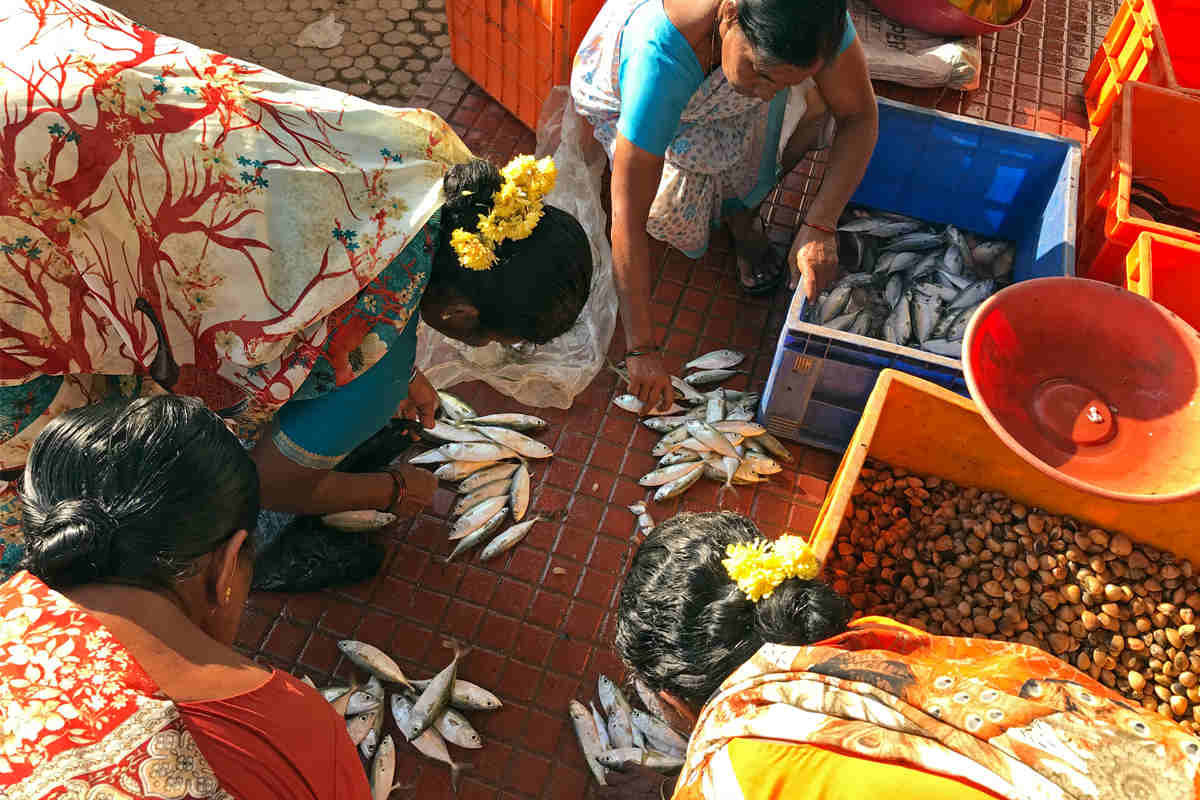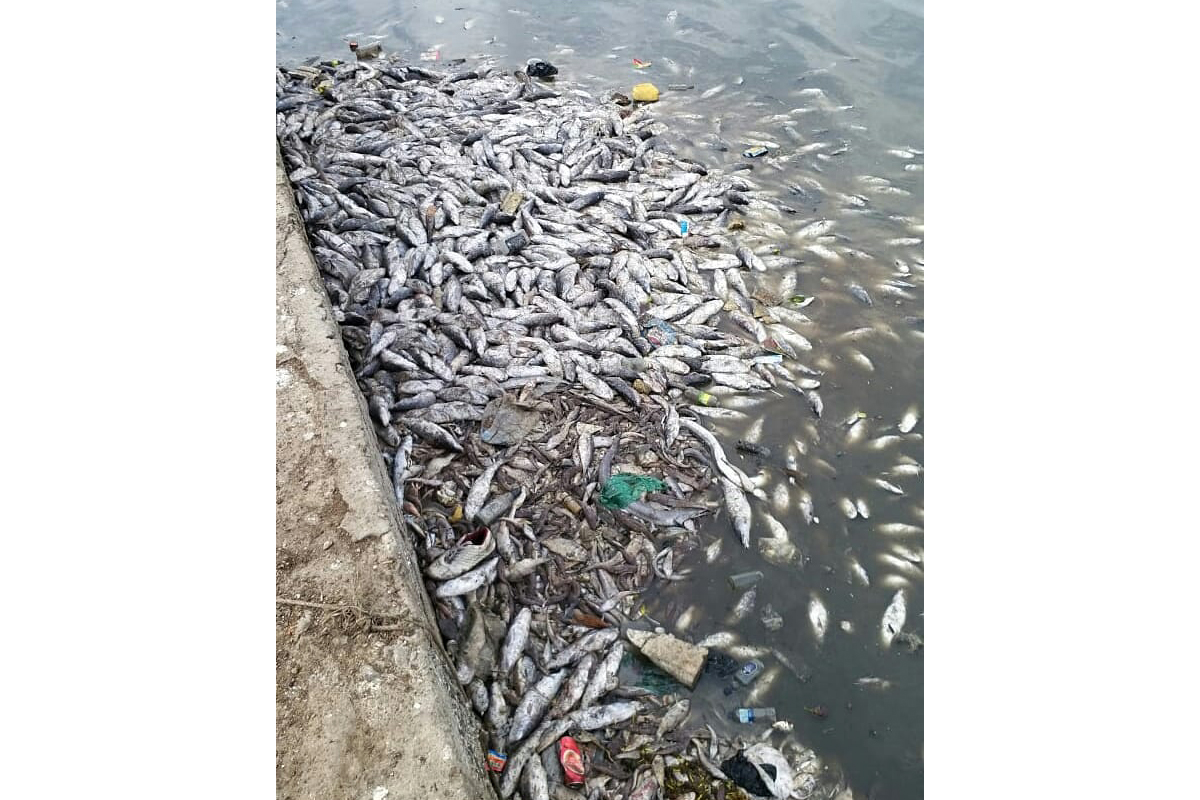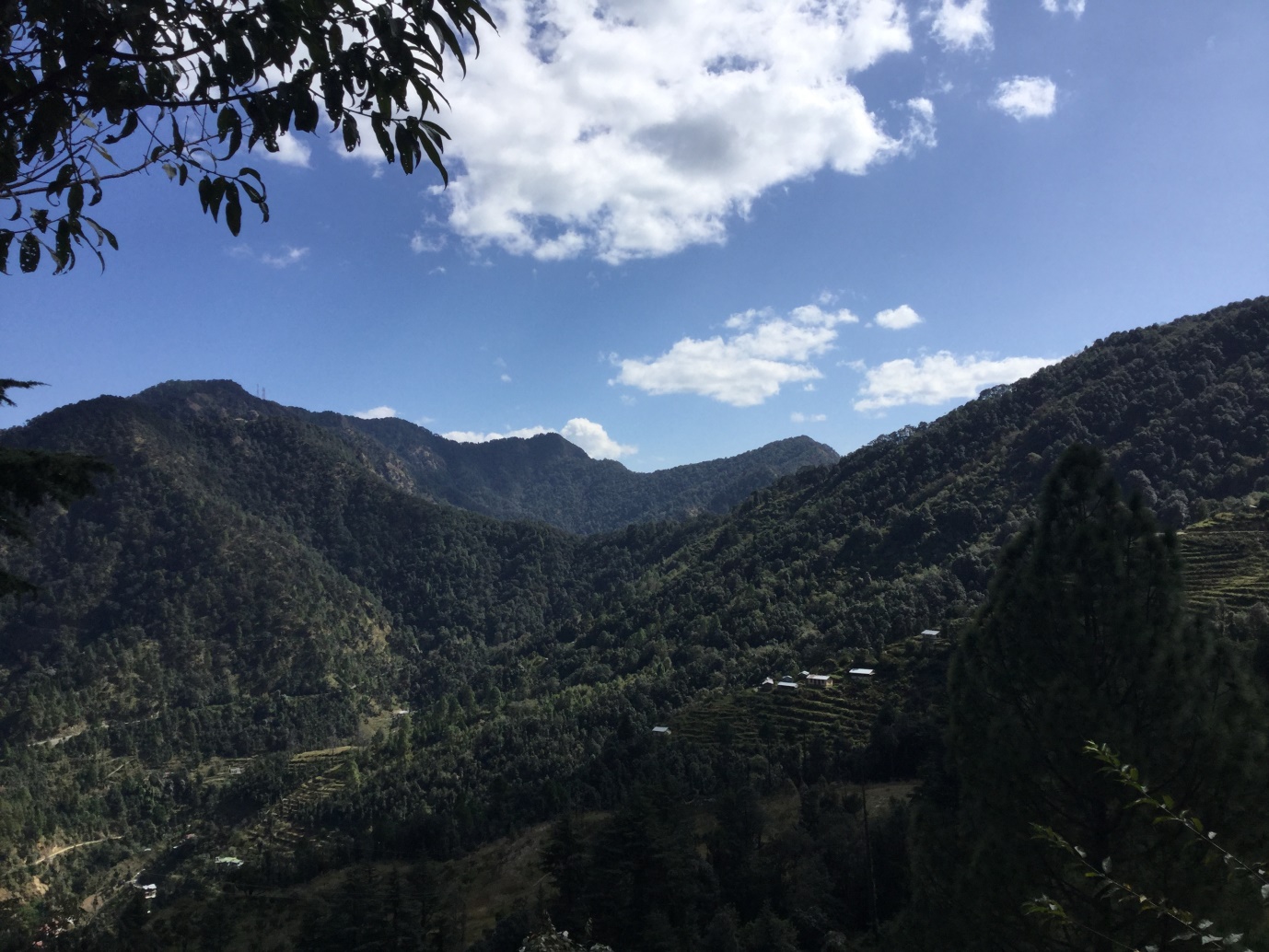
Nilesh Nakhawa was out in the sea in his purse seiner for eight days. On March 23, the 41-year-old fisherman landed at Sassoon Docks, Mumbai, in the western state of Maharashtra, at 8 a.m. with a seven-tonne haul of fish, mostly mackerel that nobody wanted. “Every single place was shut,” he said. “The traders were not there, the exporters had shut shop, no ice available, the labourers had left. Ekdum sannata tha harbour pe,” (there was complete silence at the harbour), he said.
He did eventually manage to sell off his stock but at almost half the usual price. “Usually mackerel is Rs. 70 per kilogram. I sold it to different people at Rs. 38 per kilogram.”
Many fishermen were not as lucky. Ever since the central government announced a day-long curfew on March 22, followed by a 21-day lockdown, starting March 25, to control the spread of coronavirus (COVID-19), social media and news sites are streaming with first-hand accounts of fishermen across the west coast of India throwing away their fresh fish catch. In the absence of ice, there can be no storage. In the absence of exporters and traders, there can be no selling. In the absence of fish workers, tasks such as loading and unloading of fish, transport of stock and ice and other jobs that are labour intensive and integral, cannot be performed. The fisherfolk who had just returned from the sea did not know what to do with their stock, so they threw it away or sold it at meagre prices.
Fishermen across the economic spectrum – from the large scale mechanised fleets to the small scale fishers across the coastline have suffered an economic blow due to the lockdown. Keeping in mind that marine capture fisheries is already a stressed sector, the loss of fish has created a dent in the economy and food security for a number of people.
The share of the fisheries sector in India’s Gross Domestic Product is about 1.03 percent as of 2017-18 and it contributed Rs. 1.75 trillion (Rs 1,75,573 crore) during 2017-18. It accounts for about 6.58 percent share of agricultural GDP of India. According to the government’s own estimates, the sector provides livelihoods to about 16 million fishers and fish farmers at the primary level and almost twice the number along the value chain.
“This season has already been very poor,” said Sunil Mohamed, principal scientist & head of Molluscan Fisheries Division at Central Marine Fisheries Research Institute in Kochi. “Fishermen have been complaining right from January that the catch is poor, especially in the south-west. So this lockdown has a double effect – they are already suffering from the lack of catch, and they can’t go fishing during the peak season of a stressed time. Biologically, it is good for the conservation of species, but only biologically. All fishermen, small scale and large scale are suffering. It is a loss of income for them,” he said.

Stresses in the mechanised sector
Twenty-five-year-old Siddharth Chamudiya owns a multi-day trawler. He returned to Mangrol Port in Gujarat on the morning of March 24, after a 15-day trip. “Our harbour has a capacity for 200 big boats,” he said. “We are able to place 50-100 boats at a time, and then we take the small boats to unload the catch and take it to the landing centre,” he explained.
By the time he reached the harbour on March 24, the day the lockdown was announced, almost a thousand boats were already waiting to unload the catch. “The landing site had a curfew and we were not allowed to unload,” he said. “And we needed ice, but all ice plants except one were shut” and “labour was missing.” They finally managed to unload the stock by attaching their boats to the landing site with a pulley rope and sliding the crates across. He managed to sell his fish somehow, but “at very low prices, one-fourth of the original price.”
“Transportation is not happening, and there is no labour. It is a big problem for us,” he said.
Fishermen in Diu, at Vanakbara port, had a bumper catch of catfish on that day. “My peers were saying that all boats had 2-3 tonne of catfish at least,” said Chamudiya. “But no buyers, no cold storage, so most of them had to throw it away.”
Large stocks of fish need several men to unload the stock, need ice, need storage space, need people to clean the fish, traders to sell and finally, the stocks need to be transported to the exporters who are the main clients for large boat owners. The lockdown disrupted the entire supply chain of the mechanised sector.
There are similar stories from across India’s coastline.

At the Mangalore harbour, Dakshin Kannada district of Karnataka, there were reports of large boat owners giving away their precious fish stock to fish meal plants at a pittance. “There is no cold storage here,” said Nithin Kumar, trawl boat owner and president of Dakshin Kannada Trawler Association. “Most of our stock goes to Kerala, and since all transportation has been sealed, we were stuck,” he said.
“On a regular day, 80 percent of my catch goes to exporters,” said Ganesh Nakhawa, a fisherman based in Karanja, Maharashtra. He owns a purse seiner and is the chairman of National Purse Seine Fishermen Welfare Association. “But everything has stopped now.”
The annual fishing ban begins soon after the lockdown
Roosebeh Daruwala has been running Libran Seafoods, a seafood export business in Mumbai, Maharashtra since 1987. He exclusively exports wild-caught seafood such as shrimps, lobsters, prawn etc. to hotels in tourist destinations such as Mauritius, Seychelles, Maldives and Thailand. “My business has stopped, completely,” he said.
“The decline has been happening for a while. First, we have had a series of bad seasons thanks to the cyclones, then unsustainable fishing methods have anyway reduced the fish in the oceans, we are not letting them breed, and now this. I can’t say how we will come back from this,” he said. According to him, exports were still happening but only of farmed fish and had “reduced to five percent, perhaps to China.”
“This season after Holi was supposed to be good for us,” said Nakhawa. “But now I think we are finished for the year. Will come back in September.”

Every year, the central government issues an order imposing a “uniform ban on fishing by all fishing vessels in the Indian Exclusive Economic Zone (EEZ).” This is done to ensure sea safety, as the waters tend to be rough during the monsoon, and for conservation, as this is the spawning season for several marine species. On the east coast, the ban is imposed from April 15 till June 20, and on the west coast, it is imposed from June 1 to July 31.
On the east coast, the monsoon ban begins immediately after the currently ongoing lockdown is over. On the west coast, the ban begins a month and a half later. But various boat owners in the mechanised sector of the west coast feel that fishing may not resume during this window, as most of the migrant fish workers who work as crew on boats have gone back to their home states, and among those that could not go, many are stranded in different parts of the country in deplorable conditions, desperate to go home.
“We don’t know if we will resume fishing after the lockdown. We cannot function without our crew, and it depends on them if they want to stay or go back home,” said Shashi Kumar, a trawl boat owner in Mangalore. Mangalore harbour is currently sheltering four hundred migrant fish workers, who are being provided with food and shelter by the Dakshin Kannada Trawl Boat Association.

Impact on small scale fishers and women fishworkers
“Small scale fisheries both in the inland and marine sector are finding it hard to continue fishing,” Siddharth Chakravarty who works at The Research Collective and analyses fisheries policies through the lens of labour, gender and class, said. “Which also means that they are not able to land fish and have any income, so that’s one part of the problem. And that has two manifestations — one, of course, is income, and the other is food and diet on a daily basis.”
Tajen Das of the South Bengal Fishermen Forum stressed that their livelihood has been severely impacted due to lockdown. “We have about 12,000 fishermen who are members of our association. Because of the lockdown, they are suffering as there is no work and no relief provided to them,” Das told Mongabay-India.
Chandrasekhar Shriyan refused to go fishing during the lockdown. A traditional fisherman based in Guddekopla, a fishing village in south Karnataka, he said “state government allowed us to go in a traditional non-motorised boat with maximum five persons per boat. But we were worried about our safety and health.” He and the rest of the members of Dakshin Kannada Karavali Moola Meenugarara Sangha (South Karnataka Coastal Original Fishermen Union), a union of 1200 members covering 14 villages across the coast of south Karnataka decided to impose restrictions on themselves and not go out in the sea.
But he also admitted that there has been no daily income since the lockdown. “We are self-employed people, and our income depends on our daily catch,” he said. “You know how our condition is, it has been bad since December. There is anyway less catch with the capitalists taking everything. And we have very little vegetables, rice and daal.”
“Today was our first-day fishing,” he told Mongabay-India on April 1, the eighth day of the lockdown. “People were crying, there is no food at home for many, nobody understands our situation.”
They headed out at 4 a.m. and came back by 6:30 a.m. with a “decent catch” of mackerel, and by 9 a.m. had sold everything. “We sold some of our catch at the seashore itself, and then the rest down the road. Everyone was disciplined, we practised social distancing,” he said.
When asked how the women fish sellers in his area were doing, he said, “Nobody is going out. They can’t go to people’s homes, and the markets are usually shut. Today three-four women went to the market to sell. But nobody is coming to buy fish either.”
“Women, especially single women, who constitute a majority of fish vendors (at markets, by the roadside, by head loading for door-to-door sale), are likely to be the hardest hit by the loss of access to fish, to transport systems, to markets, and to the consumers,” said Venkatesh Salagrama, fisheries professional and consultant with FAO (Food and Agriculture Organisation). “Their day-to-day subsistence economy takes a hit, so the impacts at the household level can be severe.”
Lakshmi Kowada, president of Traditional Fish Workers Union in Visakhapatnam, Andhra Pradesh also runs a fisherwoman society in her neighbourhood. “We have 500 women members,” she told Mongabay-India. “Everyone is in trouble. We had Rs. 600,000 (Rs. six lakh) worth of dry fish to be exported to Kerala. It is stuck at Visakhapatnam railway station and is now spoilt. What are we going to do? My women sell fish house to house. They are sitting at home. There is no money for any ration. They have families to feed. They are calling me every day, begging for some rice, for some daal. What am I supposed to do?” she questioned.
Mangaraj Panda of Samudram, a federation of women fishworkers in Odisha, narrates a similar plight.
“The fishermen are not going to catch fish and if they are being allowed there are so many instructions to be followed that they think it is better to not do it. Even if someone has gone then there is no trader or nearby villagers to buy their catch. To make the best of the worst time, some fishermen are storing their catch as dry fish which they will sell as feed once lockdown is lifted. The whole ecosystem is severely impacted. We are not getting essential services or compensation. Only some people have got a little compensation so far. If the issue is not addressed soon things will go beyond everyone’s control,” Panda told Mongabay-India.

Relief package for farmers, leaves out fishers
After the lockdown, a Rs 1.7 trillion (Rs 1.7 lakh crore) relief package was announced for farmers under the Pradhan Mantri Kisan Samman Nidhi. It left out traditional fish workers, who are not included in the scheme, prompting a letter from the National Fishworkers Forum on March 26, demanding a relief package.
The union ministry of fisheries sent letters to the fisheries departments of all states on March 26 and 30, requesting details of fish workers in their states, so that relief measures could be worked out. Since fisheries is a state subject, the onus to act lies upon the state government. In a letter dated April 1, the National Fishworkers’ Forum wrote to the union ministry, stating that “the delay in…. addressing their hardships… is highly regrettable”. It reiterated their demand for “a monthly allowance of Rs. 10,000 per month for up to three months be provided to each fishing household in advance. This should be uniform to all workers across the fisheries value chain.”
The letter also said that women engaged in fish vending and other allied activities should be “specially mentioned in the relief package and it should be ensured that relief is provided to them on a priority basis.”
T. Peter, who is the secretary of the National Fishworkers’ Forum (NFF), an umbrella body of the state-level fishworkers’ associations, said, fishermen in all of coastal India are facing a very tough time. “In several areas, fishermen are staying in their boats at harbours because if they come on land they will need to go under quarantine. The situation is alarming and if not addressed in time the whole system will collapse. We have appealed for a special package for our community,” Peter told Mongabay-India.
“The compensation we have sought is even less than the minimum wages set by the government. Fishermen not just take care of the food security but we also protect the country’s coast from intruders and earn foreign currency from exports. We obeyed the prime minister’s order on lockdown but now it is time the government takes care of us. If the government fails to support us then fishermen will face a disaster much worse than coronavirus,” Peter said.
According to local reports, Kerala has allowed country crafts to venture into the sea from April 4, and fishermen have been allowed to sell their catch without going to open auction. In Goa, according to the reports, the fisheries department has allowed the sale of fish from April 6, as there are “at least 500 tonnes of fish stock lying in cold chains.”
For Salagrama, though, the problem is far more deep-rooted. “Once the emergency is over, who is going to bother about the fishers or their livelihood sustainability?” he asked.
“It may be that the lockdown is showing up their problems in high relief, but the fact is that the lockdown is temporary, their problems aren’t. They have their backs to the wall and are struggling to make ends meet at the best of times and unless more structurally sound foundations are laid for more sustainable fishing-based livelihoods, it is likely that their ability to cope with lockdowns and sundry other disasters will only worsen.”

[With inputs from Mayank Aggarwal]
Supriya Vohra is an independent journalist based in Goa.












